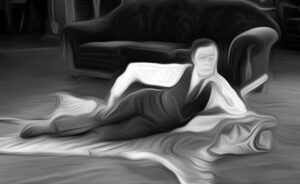
Nearly a hundred years ago, a muscular young actor-director named Buster Keaton risked his life and limb to entertain moviegoers in his film Sherlock Jr (1924). The film follows a movie projectionist that dreams himself into a film. Today, it still thrills. I found myself saying: ‘HOW did they do that?’ aloud at various points.
Unlike many other contemporary movie-makers, Keaton cuts to the chase, deliberately using half the usual number of intertitles. If you’ve been put off black and white movies by seen too many words onscreen, try Keaton’s movies. And what chases! Keaton perches on the front of a motorcycle – unaware that its driver has fallen off – as the vehicle hurtles along a high bridge with a huge gap, crosses approaching trains, towards a tree about to dynamited.
From the age of five, Buster Keaton performed onstage with his parents, never lost the sense of what amuses an audience. In Sherlock Jr, he performs the genuinely dangerous stunts himself.
What’s special about this film is not the paper-thin plot, but the way Keaton tells the story: as a love affair with film. Keaton began his film career by taking home a cine-camera, dismantling and reassembling to understand how it worked. That cinephilia and attention to detail is evident onscreen in this film, his first sole directorial venture. Arguably, this is ‘pure’ cinema – beyond the narrative of words – showing movement, the element which eludes the other arts such as painting and photography.
There’s an iconic moment in Sherlock Jr. where Keaton as the projectionist falls asleep during a movie – and in a beautiful double exposure – leaves his sleeping body and in his dream, enters the film being projected to save the heroine (who resembles his girlfriend). At this point, film students will be scribbling cryptic comments like ‘dream state – visual – other realities – projection of desires – film within a film – auteur!’ in their notebooks. But for all viewers, the level of excitement rises because the real action is beginning: the chases and disguises.
In his dream, Keaton is the greatest detective of the title, clad in a top hat, morning dress and spats. For an actor who often chose to dress like a shy, put-upon everyman, this is a new, cool act. The act is maintained even through one genuinely tense scene where there are three separate assassination attempts.
Silent film is, of course, not silent. There is bespoke music throughout, scoring every beat of nuance, comedy or shock.
While writing this review, I bought (for the price of a cinema ticket) a three-disc Blu-ray set which includes Keaton’s masterpieces: The General (1926) and Steamboat Willie (1928) and a documentary on his films, which adds the appreciation of his filmmaking style. When a man risks his beck (and breaks it) on film, its seems like the least I can do by way of appreciation.
Written for The Film Dispatch by Heather Gregg.

